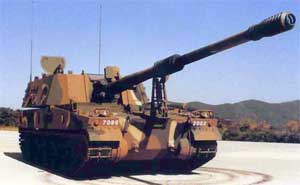Articles >>
Samsung Techwin K9 Thunder Continues to Drive The Self-Propelled Artillery Market
Category: Defence Industry

The international market for self-propelled artillery remains a highly competitive and dynamic environment. In its annual analysis "The World Market for Self-Propelled Artillery Systems" the Forecast International Weapons Group expects the market will produce over 4,500 self-propelled artillery systems, worth about $14.03 billion, through 2015. Dean Lockwood, a weapons systems analyst at Forecast International, notes that the market reflects three design factions. Most armies rely on tried-and-true older designs, such as the classic BAE Systems Land & Armaments (formerly United Defense LP) M109 series. Newer designs tend to borrow liberally from this benchmark design. According to Lockwood, “Reflecting the basic design concept of the M109 style of self-propelled howitzer, the Samsung Techwin K9 Thunder program continues to stand out as the clear market leader.” We expect the K9 Thunder (along with its licensed TUSpH Storm program in Turkey) will account for 21.76 percent of all self-propelled howitzer production worldwide, worth a commanding 31.02 percent of the market, through 2015. Competing with the M109-style design is the emerging class of wheeled self-propelled artillery designs, optimized for the rapidly deployable medium force option. Designs such as the General Dynamics Land Systems Stryker Mobile Gun System (MGS) and the Giat Industries CAESAR offer the advantages of lighter weight and enhanced mobility, as well as lower production and maintenance costs. Lockwood notes that, "Over the past five years, our forecast regarding the combined market share of wheeled designs has doubled." We now expect the wheeled systems will account for 7.64 percent of all new production, worth 8.37 percent of the market, through 2015. At the extreme high end of the market, we find the truly state-of-the-art systems, notably the Krauss-Maffei Wegmann Panzerhaubitze 2000 and the Mitsubishi Type 99, which command correspondingly high-end unit prices. In terms of forecast production, both the PzH 2000 and the Type 99 remain relatively minor players, accounting for only 6.26 percent and 3.26 percent, respectively, of all new production through 2015. Yet, according to Lockwood, "These programs continue to be significant factors in terms of market value." Through 2015, we expect the PzH 2000 will account for 11.44 percent of the total market value; the Type 99 will maintain a market value share of 9.58 percent during that period. Despite the uncertainties of the post-Cold War world, new threat scenarios, and transformational military doctrines, conventional tube artillery continues to offer an unmatched capability to reliably deliver accurate and effective fire under all conditions -- when and where the infantryman needs it. |
Forecast International |
L&T Wins Largest Private Sector Defence Order for Artillery Guns
14.05.2017
Maintaining Bradley Fleet Rivals Spending on New Light Tracked Vehicles Worldwide
13.07.2007
CAESAR and Stryker MGS Gaining Share of The Self-Propelled Artillery Market
05.05.2007
Booming Saudi Arms Buying Leads Middle East Arms Market
12.12.2006
Forecast International – Europe & Middle East
K9 Thunder (Self-propelled howitzer)
Discuss
